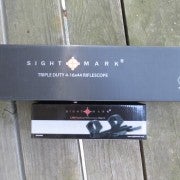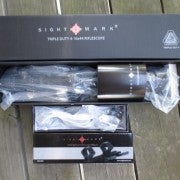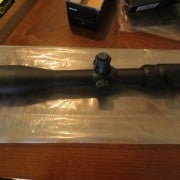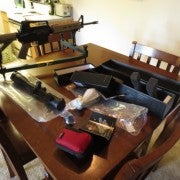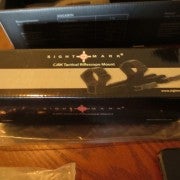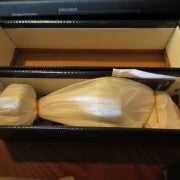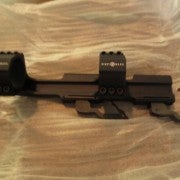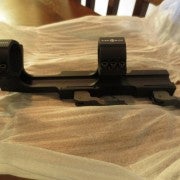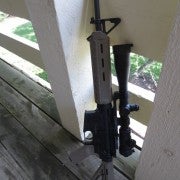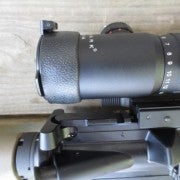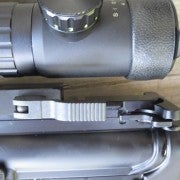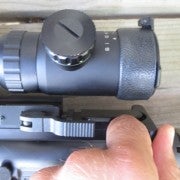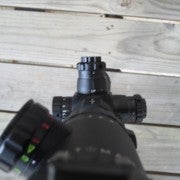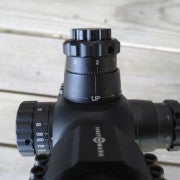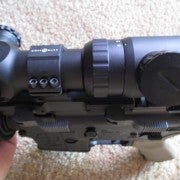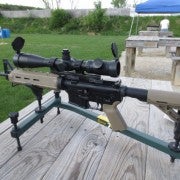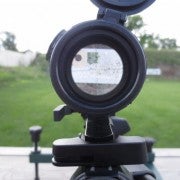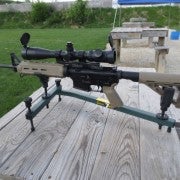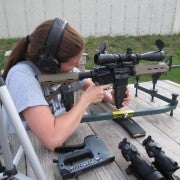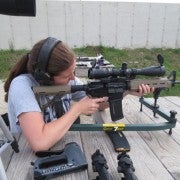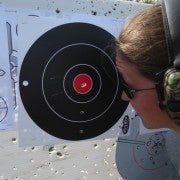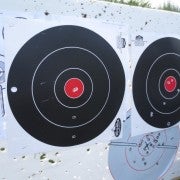Since its introduction in 2007, Sightmark has been aggressively expanding its product lines. Originally oriented as a value-focused brand, recently they have been making moves up-market with their new Ezekial line (which we also have for testing). Now, Sightmark is a full-line optics manufacturer with options for prismatic sights, red dots, night vision, and magnifiers. This is on top of over a million boresights in use and other accessories including binoculars, spotting scopes, flashlights, and mounts.
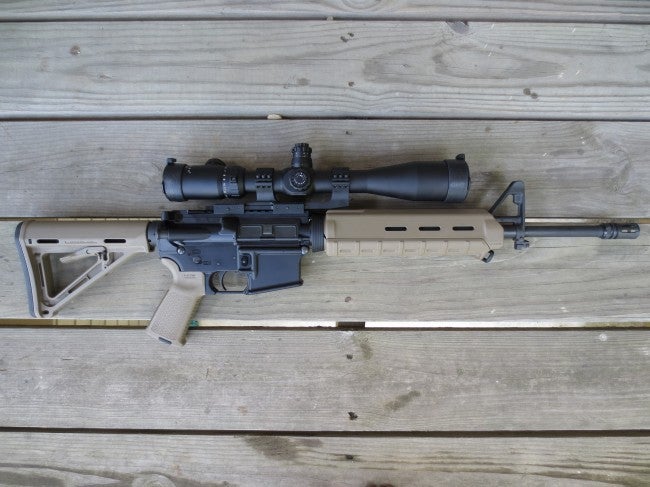
Mounted to the test platform and ready for the range.
SIghtmark was eager to get a scope in my hands after the NRA show. So much so that I got the choice of the entire product range. Endeavoring to pick a scope that would most typically model the line, I opted for the Triple-Duty (Tactical, Hunting, & Competition) 4-16x44mm Mil-Dot-Dot reticle. Since I am not someone who likes to “click” to my target (as I forget how many clicks I make), the MDD was ideal for holdover shooting.
To compliment the scope, Sightmark suggested that I use their new CJRK mount complete with adjustable tension throw-levers. Taken together, it was a complete scope package that looked to compliment my favorite shooting, semi-auto’s at medium ranges.
Mounting & Shooting:
The test platform for shooting was one of my trusty Del-Ton/Aero Precision LW AR-15s. Having put significant rounds down range I knew the rifles dope with my typical ammo and have been able to ring steel past 500 yards with irons on a regular basis. With 55 grain FMJ ammo, it is an surprising 1.5 MOA rifle.
The scope arrived in typical retail packaging. I dare say its an attractive box, with none of the bare boring cardboard that typifies scopes in this price range. Opening it up, the scope is nestled into shaped foam, keeping it safe until it was ready to be opened and mounted. The caps were already installed with the hinges on the top – nice attention to detail. The scope mount did not have the same full treatment, instead wrapped in thin foam sheeting. Its just enough to keep the aluminum from scratching itself.
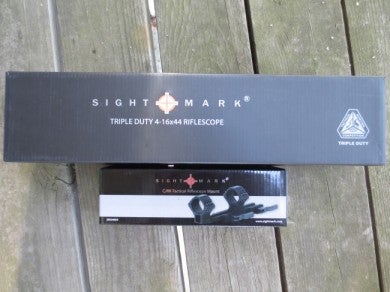
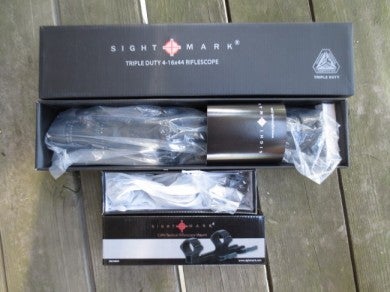
Packaged ready to return to Sightmark. The CJRK mount originally came with rubber bands on it to the foam sheet in place. See the Gallery at the end for better photos.
Taking both the scope and mount out of their packing, I inspected each for defects. There was no obvious machine marks and the finishes were both a nice black matte. I set up the rifle for mounting, using my Wheeler Level-Level-Level and FAT wrench. Annoyingly, the screws on the mount were metric and I could not use my good torque driver for my normal OCD mounting methods.
The CJRK mount was easy to use. The throw levers are quite large, making them easy to close down into place. I set the pressure for what I could shut easily without being able to move the mount when hit with a rubber mallet. Each 30mm ring uses six (6) allen keys to provide even pressure across the tubes. Torquing each into place, the scope was stable in the mount and on the rifle.
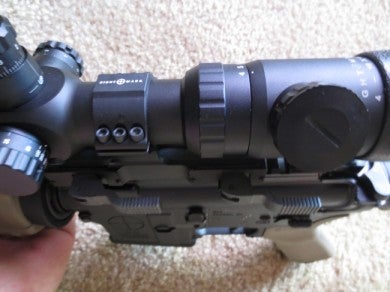
Note the long throw-levers and the six screws.
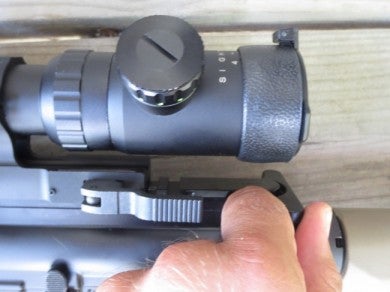
My first mounting position with the mount towards the rear. The throw levers were too long and get on the way of weapons manipulation. I moved the mount farther up on the receiver and it solved the issue nicely.
Initial zeroing was performed at 25 yards and then adjusted and confirmed at 50 (for my medium-range rifles, I like a 50 yard zero). With 55-grain .223 it took only 6 shots to bring the holes into the red of my splatter targets. Using the 1/8″ MOA clicks, the adjustments were spot on, if not tedious. The first shot was 4″ low and 6″ to the left. Fortunately, the scope has 60 MOA of adjustment was able to get where it needed to be. After zero, three shots easily created a continuous ragged hole.
Sighting in, the glass provided crisp images with no blurring around the edges. We used 9x magnification for the extreme short-range work to ensure that we were spot-on. Eye relief had a large enough window that my wife and I were able to shoot without changing the stock position (I position my head forward, she likes to keep hers back). No scope bite either!

The zero targets. The right hand shows the shot progression. The left is my wife’s first three shots on target.
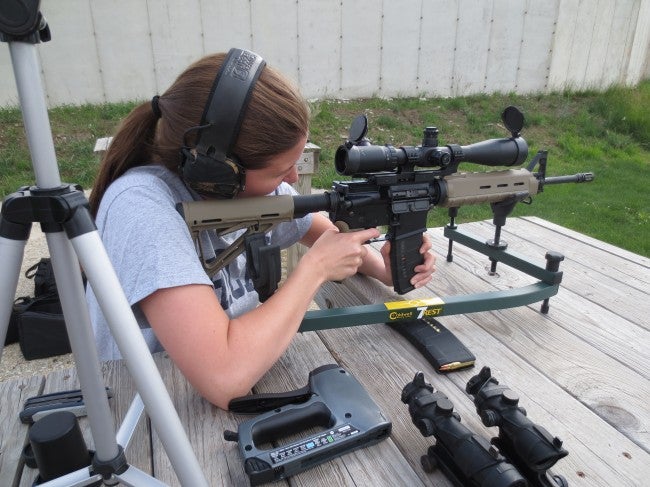
We stepped back to 200 and 300 yards and stepped up the magnification to the full 16x. With its second-focal plane reticle the Mil-Dot-Dot reticle accurately demarcated correct hold-overs. Stepping out to 600 meters, the first shot at range rang plate steel.
As dusk settled across the range we noticed the scope start to darken quickly. For 50% ambient light, the scope darkened another 50%. Usable, but harsh. In the lower light, the reticle was harder to see. To compensate, we turned on the built-in 3V illumination. On red or green settings, the reticle was easy to pick up. Each color has 6 settings that ranged from light illumination to bright enough to star the central dot.
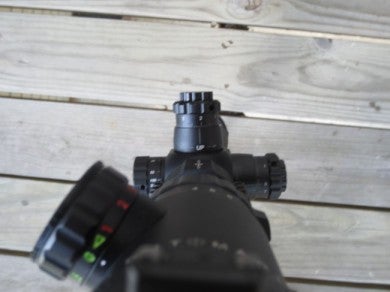
The adjustment turrets and offset illumination settings.
Turning the magnification back down brightened the image up dramatically. Under 10x zoom, the scope returned to its charismatic brightness. However, we did notice that the mount was sliding on the rails on the receiver. The constant shooting (over 200 rounds at this point) was too much for my original tension setting. Taking the scope off, we turned each throw lever in another revolution and remounted. Re-testing zero showed that the scope drifted about 1 MOA to the right. 8 clicks later, it was back on.
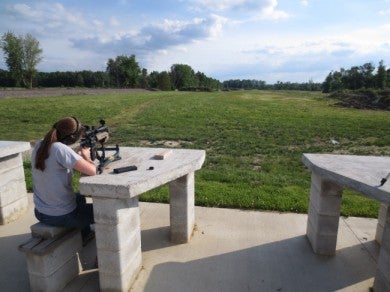
Satisfied with operations on a light-recoiling AR, I pulled out my 12 gauge. Mounted on a Remington 870, I blasted away with an assortment of rounds including low-brass birdshot, high-brass buckshot, and 1 oz. Magnum slugs. The scope took the beating in stride.
Remounting to the AR, there was another 1 MOA shift, this time down (I blame the remounting, as there was similar shift earlier). Firing a quick string yielded no additional changes. For good measure, I put another round on at 600 yards. With the satisfying “clang” I turned-to from testing to turn my thoughts into this review.
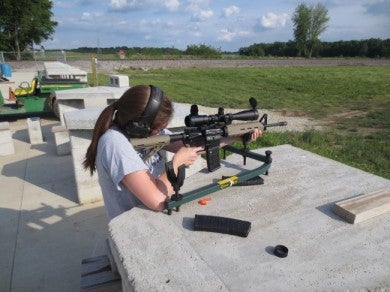
The Good:
- Crisp glass in all conditions where you would expect it.
- Turrets have affirmative clicks, the adjustments were spot-on, and turrets can lock into place.
- MDD reticle was accurate out to all distances tested.
- The mount rings were stable, easy to adjust, and matched the scope size.
- MSRP is $239.99. Most retailers have them at just under $200
The Notable:
- High magnification will darken in lower-light conditions past 10x zoom. Even with the increase in front diameter, the exit pupil at high magnification is below 4mm.
- For AR’s, the CKRT’s extended tension handles can get in the way of the charging handle.
- Illumination is only the center dot. It does not light up the entire reticle.
- Side focus knob on the left side is easy for right-handed shooters. Lefties are left wanting.
The Bad:
- Mil-Dot-Dot reticle with MOA turrets is sometimes confusing.
- The scope can handle recoil and maintain zero, but one will have to make sure they tighten the mount one turn past what you would expect to be sufficient tension.
Final Thoughts:
The scope does all you ask of it, it just doesn’t do much more and does it with little fanfare. (That’s not necessarily a bad thing.) To draw a metaphor, this is the Windham Weaponry of the scope world. Its quality, does the job, and provides good value, but don’t ask it for the bell’s and whistles.
The optics are bright in good daylight conditions and below 10x are perfectly usable in low-light. The adjustments were accurate, and the locking feature is excellent for this particular reticle. Using the dots, we were able to compensate for wind and distance without having to touch the turrets.
Those looking for value-oriented optics should take a hard look at the Sightmark Triple-Duty line. With various reticle options and good mounts to match, the Triple Duty is perfect for casual shooters and those not looking for all those ” extra features.” This is a Chevy to those not on the Cadillac budget.
The limited lifetime warranty is just icing on this cheap cup cake.
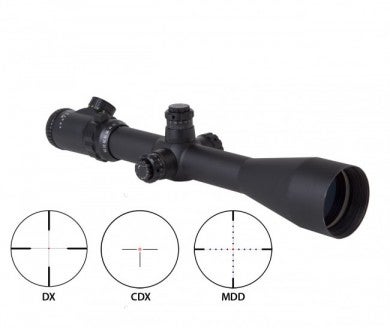
Various reticle options for the Triple-Duty scopes.
Gallery:
Specifications:
| Reticle | Mil-Dot Dot Reticle | MOA adjustment (one click) | 1/8″ |
| Reticle Type | Etched | Maximum Recoil (G’s) | 1200G |
| Reticle Color | Black, Red and Green | Battery Type | CR2032 |
| Illuminated | Yes | Battery Life (hours) | 80-150 |
| Reticle Brightness Settings | 0-5 | Battery Voltage (V) | 3V |
| Finish/Color | Matte Black | Sunshade | No |
| Magnification (x) | 4-16 | Waterproof/Nitrogen-filled | Yes |
| Objective Lens Diameter (mm) | 44 | Shockproof | Yes |
| Eyepiece Diameter (mm) | 37 | Fog Proof | Yes |
| Exit Pupil Diameter (mm) | 11-2.75 | Focal Plane | 2nd |
| Eye Relief (mm) | 120.1-88.4 | IP Standard | IP66 |
| Field of View (m@100m) | 9.61-2.44 | Body material | 6061 Aluminum |
| Field of view (ft @100yd) | 31.5-8 | Lens material/type | K,ZF,BaK |
| Diopter Adjustment | +2/-3 | Lens Coatings | Fully Multi-Coated |
| Tube Diameter (mm) | 30mm | Mount Type | Weaver |
| Tube Piece | Single | Operating Temperature (°C/°F) | -20 to 60 / -20 to 140 |
| Parallax Setting (yds) | 12 to Infinity | Storage Temperature (°C/°F) | 5 to 35 / 41 to 95 |
| Windage Adjustment Range (MOA) | 60 | Length (mm) | 376 |
| Elevation Adjustment Range (MOA) | 60 | Width (mm) | 85 |
| Windage & Elevation Lock | Yes | Height (mm) | 75 |
| Weight (oz) | 28.2 |
 Your Privacy Choices
Your Privacy Choices

